At Digi we offer a wide range of wireless modules that can help get a new product up and running in no time. Digi XBee® RF products are built to the highest quality standards and come with all of the tools and code libraries that developers need to quickly integrate them into IoT devices.
The Digi XBee Product Line
Digi XBee wireless modules can be divided into two main categories: Short range and long range.
Short-Range XBee Modules
Our short-range modules operate on 2.4 GHz and support various protocols. One of these is 802.15.4, which allows for fast, low latency point-to-point and point-to-multipoint communications. This can be useful for remote control applications, and when all devices are in direct range of each other. We also offer two mesh technologies: Zigbee and DigiMesh. Both can be used to create intelligent, self-routing and self-healing mesh networks. Zigbee is an open, interoperable standard. DigiMesh, a protocol developed by Digi, supports completely battery-powered mesh networks.
The modules come in multiple hardware variants to support different use cases. They are pin compatible as well as software compatible, to make it easy to switch from one technology to another. This allows a solution provider to easily migrate to a newer module when it is released. In addition, the modules come with global certifications. These certifications reduce the time to market since the manufacturer typically does not have to worry about getting the module certified in their region.
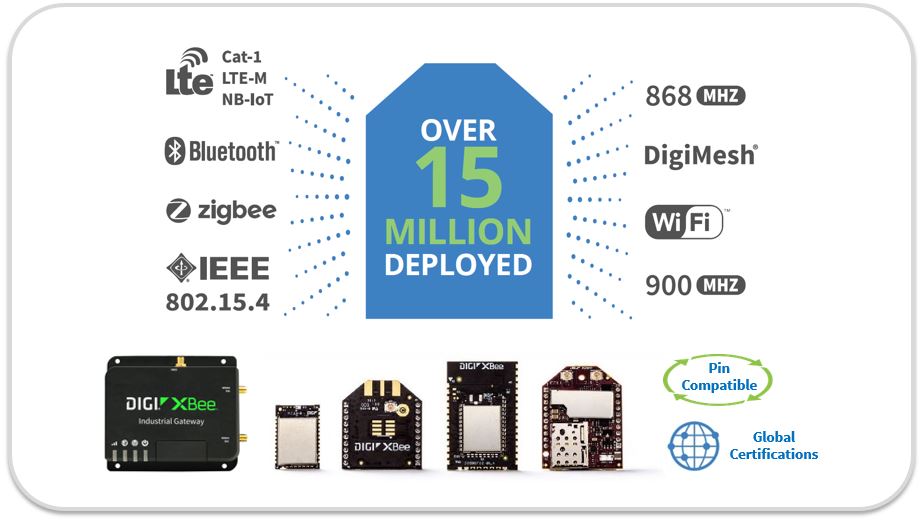
Long-Range XBee Modules
Long-range applications can be implemented using either our sub-GHz modules, which support 868 MHz and 900 MHz, or the Digi XBee cellular modules.
A sub-GHz module provides increased range and improved material penetration at lower throughput compared to 2.4 GHz, making it a viable candidate for long-range applications or challenging indoor environments.
Cellular XBee Modules
Last but not least, Digi XBee modules support a variety of cellular standards, including 3G, LTE Cat-1, LTE-M, and NB-IoT.
The cellular XBee product line supports many mobile and industrial applications where Wi-Fi access is challenging.
Not sure which type of connectivity is right for your application? Contact Digi.
Form Factors
Digi currently offers three different hardware variants:
- A micro module that’s referred to as MMT
- A through-hole module, which has pins attached on the bottom
- A larger SMT module for backwards compatibility to legacy XBee modules
The Digi XBee cellular module is a variant of the through-hole form factor with additional UFL connector and a SIM card slot. All of these modules offer various antenna options depending on the actual variant used, such as PCB or chip antenna, UFL, SMA, and RF pad connector.
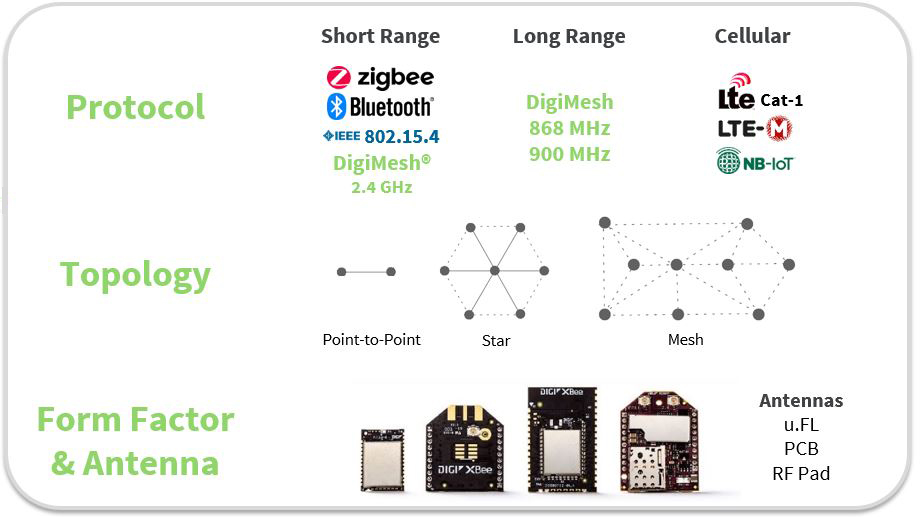
Digi XBee - A Complete IoT Networking Solution
Digi’s mission is to help developers simplify and accelerate the development, deployment and management of secure connected devices. We help our customers to save time and money while reducing risk, and enable them to focus on their core competency instead of embedded wireless design complexity. This philosophy is also reflected in the RF product range.
XBee RF modules are the foundation of a complete IoT networking solution. In addition to hardware, Digi is offering a vast amount of hardware and software tools to accelerate and simplify tasks in all the different product and development lifecycle phases.
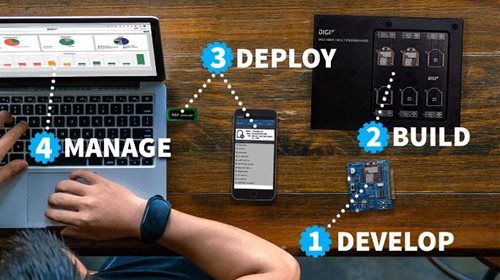
Software, Tools and Development Kits
Digi XBee is supported by an entire suite of products to make the development process as fast and simple as possible. Called Digi XBee Tools, this award-winning suite of hardware, software and libraries supports the entire product lifecycle, including:
- The development of the product including hardware and software design
- Building or manufacturing the final end product
- Deployment, commissioning, and mass-rollout of the product in the field
- Ongoing management, maintenance and communication with devices in the field
Our wide range of software and hardware tools can be used by developers, the manufacturing team, engineers and even the service personnel in the field. Many of these tools are provided by Digi completely free of charge.
Here are three examples:
- Digi XCTU® for configuration and testing. If you are just starting with the Digi XBee module, be sure to read the useful overview of the features included in our popular XCTU tool. XCTU has features for configuring, mapping and range testing your devices. Learn more in this blog.
- Digi XBee PyCharm IDE plugin. If you are planning to integrate application logic into the XBee module directly using the MicroPython programming language, check out the Digi PyCharm IDE plugin, which allows you to deploy and debug code directly on the module using a powerful development suite
- XBee Mobile SDK. To utilize the additional Bluetooth communication option, developers can use the Digi XBee Mobile SDK for Bluetooth to create mobile apps communicating to the XBee using Bluetooth for data communication and management
Security with Digi TrustFence
Digi's premier security product is a framework that we call TrustFence®. The TrustFence framework provides several fully implemented security features for the XBee module. For example, secure boot ensures that only authorized, digitally signed firmware is running on the module. Secure storage encrypts the local file system and the secure connections feature authenticates and encrypts data communication.
The Digi TrustFence value proposition is that it allows a manufacturer to safely integrate a wireless module without having to spend time and money implementing a security suite.
Remote Connectivity: Industrial RF Gateways and Digi Remote Manager
For products that do not have an IP stack included directly, such as the 2.4 GHz and sub-GHz modules, we provide off-the-shelve, programmable gateways that provide a bridge between RF and IP for remote connectivity, if it is required. IP interfaces supported are cellular, Ethernet and Wi-Fi. Different variants of gateways are available for different use cases, including harsh and demanding industrial applications.
XBee cellular modules have an IP stack included and can connect directly to the Internet.
Customers can use or implement available or custom protocols for server, backend or cloud communication. We provide examples and instructions to connect to the major cloud providers such as AWS or Azure.
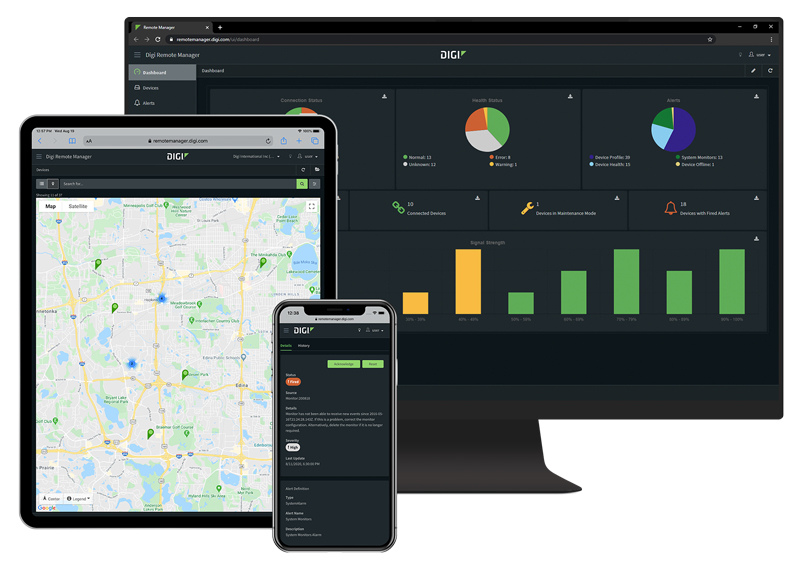 In addition, customers can utilize Digi’s cloud based device management and communication platform, Digi Remote Manager®.
In addition, customers can utilize Digi’s cloud based device management and communication platform, Digi Remote Manager®.
Digi Remote Manager provides management features such as automatic, secure firmware updates, configuration settings, status and device health monitoring, alarms and much more.
With Digi Remote Manager, you have full access to XBee modules, not just cellular, but also modules connected through a gateway. This enables you to access data from your end nodes with other applications, such as web or cloud applications using open APIs provided by the platform.
You can also perform out-of-band management using Digi Remote Manager, which provides secure access through a command line and a serial connection. You can read more in our related blog post.
Creating a Future Proof Solution
The footprint, pin out and software compatibility between Digi XBee modules allows developers to create future proof solutions. For example, developers can easily migrate to a newer module without changing carrier boards or software implementations. This is one of the major benefits of using an XBee module. In addition, many of our wireless products have been on the market for a decade or longer; product longevity is a key philosophy at Digi.
These benefits are typically not available if you choose a less integrated module or a discrete design.
Methods of Integrating the Digi XBee Module
.JPG?lang=en-US)
XBee RF modules support three main use cases for RF communication solutions:
- Using the module as a simple communication device
- Connecting the XBee module to a micro controller or embedded device for communication
- Running application logic directly on the XBee module
To support the first use case, for example to create a simple serial cable replacement solution, the module can be set up using configuration parameters provided by the software stack running on the module itself.
Digi also provides libraries that allow developers to create applications using the module as a communication device. This makes it easy to connect a module to a microcontroller or embed it within a more sophisticated device such as a custom RF gateway which covers the second use case.
In addition, Digi provides a powerful API communication mode, which allows developers to utilize all the features of the protocols and the module itself. That includes acknowledgment and status messages, diagnostics, network discovery, remote configuration, remote firmware updates, remote access of hardware interfaces such as analog I/O or digital I/O, and more.
In the third use case application logic is running on the XBee module directly. This can be implemented using the MicroPython programming language, allowing developers to add edge intelligence to their products. An external microcontroller is not required in this case. Several examples for standard or custom protocols, and for communication to sensors and actuators connected directly to the module are available.
Building the Final Product
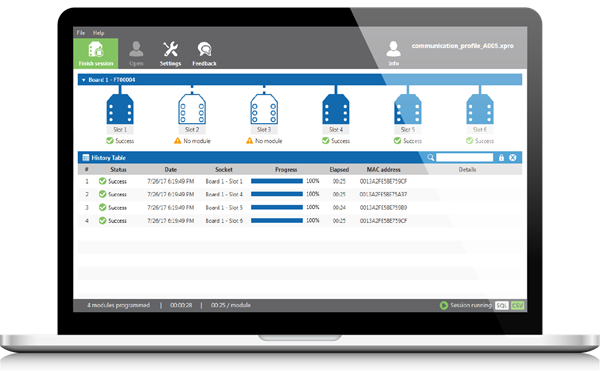 Digi XBee Multi Programmer. The multi-programmer is a hardware board that allows concurrent programming of up to 6 XBee modules, including module or cellular modem firmware updates and the deployment of configuration settings and MicroPython code. Multiple programmers can even be connected to increase the number of modules being programmed at the same time.
Digi XBee Multi Programmer. The multi-programmer is a hardware board that allows concurrent programming of up to 6 XBee modules, including module or cellular modem firmware updates and the deployment of configuration settings and MicroPython code. Multiple programmers can even be connected to increase the number of modules being programmed at the same time.
For the deployment of products in the field, Digi provides a software tool called the Digi XBee Network Assistant. The assistant is designed to simplify the mass roll-out process such that multiple devices can easily be installed in a short amount of time. Instead of using a logical map, the XBee network assistant uses a physical map (like a floor plan) to create a visualization of network routes and link quality. In addition, the Digi XBee 3 USB Adapter is an XBee node contained within a USB stick that can be connected to PCs directly, obviating the need for a development board. We’ve found that this tool is especially useful for workers who are doing onsite installation and maintenance of products.
Pre-Certified Modules
Wireless certifications can create all sorts of headaches, hold up the entire development process, and impact your go-to-market timing. This is especially true if you are rolling out a product line in different regions.
Using a Digi module simplifies this process, as many of our modules are pre-certified in many regions of the world, including the United States and countries throughout Europe. Developing with pre-certified modules can dramatically reduce costs and eliminate the risk of building additional iterations of the product to pass certification requirements.
Applications and Use Cases for Digi XBee
Digi wireless modules have a wide range of use cases, and there are countless examples of how our modules can be integrated into hardware in order to enable remote operations.
Our customers build everything from novel and interesting applications like remote controlled lawnmowers, to industrial applications like hand-controlled units for cranes and monitoring of agricultural feed bins, to the essential, such as wireless emergency lighting. Here are just a few of our favorites:
- Taiga Motors - Electric power sports vehicles
- bioFeeder - Automated feeding systems for shrimp farms
- Ranch Systems - Field monitoring and control in agricultural applications
- Floobotics - A robotic, sanitizing floor cleaner for hospitals and medical facilities
In addition to our customer case studies, you can browse our examples and guides, and project gallery for examples.
More than just functional, Digi XBee modules are built to the highest standards to ensure years of continued service even under the most demanding of conditions.